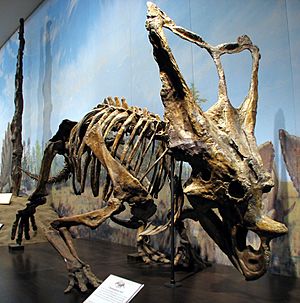Dinosaur Provincial Park facts for kids
Quick facts for kids Dinosaur Provincial Park |
|
|---|---|
 |
|
| Location | County of Newell / Special Area No. 2, near Brooks Alberta |
| Area | 73.29 square kilometres (28.30 sq mi) |
| Founded | 1955 |
| Governing body | Alberta Tourism, Parks and Recreation |
|
IUCN Category III (Natural Monument)
|
|
| Provincial Park of Alberta | 1955 |
| Type | Natural |
| Criteria | vii, viii |
| Designated | 1979 (3rd session) |
| Reference no. | 71 |
| Country | Canada |
| Region | Europe and North America |
| Lua error in Module:Location_map at line 420: attempt to index field 'wikibase' (a nil value). | |
Dinosaur Provincial Park is a special place in Alberta, Canada. It is about 220 kilometers (137 miles) east of Calgary. This park is famous for its amazing badland landscape. It is also one of the best places in the world to find dinosaur fossils!
The park is in the Red Deer River valley. It has a unique look with its rocky hills and deep canyons. Scientists have found 58 different kinds of dinosaur species here. More than 500 dinosaur bones have been taken from the park. These fossils are now shown in museums all over the world. Because of all these incredible finds, the park became a UNESCO World Heritage Site in 1979. This means it's recognized as important for everyone on Earth.
Contents
Discover Dinosaur Provincial Park
The Dinosaur Provincial Park Visitor Centre is a great place to start your adventure. It has cool exhibits about dinosaurs and fossils. You can also learn about the park's geology and nature. There's a video theater and a gift shop. Sometimes, you can even watch scientists prepare fossils! During the summer, the park offers fun programs for visitors.
John Ware's Cabin is also near the visitor center. This old cabin belonged to John Ware. He was an African-American cowboy who was important in Alberta's ranching history. The cabin is open on certain days in the summer.
History of Dinosaur Provincial Park
Dinosaur Provincial Park was created on June 27, 1955. It was made to protect the amazing fossil beds found there. Roy Fowler, a farmer and fossil hunter, was the park's first warden.
The park was named a UNESCO World Heritage Site in 1979. This was because of its important badlands and river habitats. It was also recognized for the many important fossils found there.
For many years, dinosaur discoveries from the park went to museums worldwide. These included museums in Toronto, Ottawa, New York City, and Chicago. But in 1985, things changed. The Royal Tyrrell Museum of Palaeontology opened nearby. Now, many fossils stay closer to home.
Nature and Wildlife
The park is home to a very special mix of nature. It has three main types of areas: open grasslands, rocky badlands, and riverside forests. Even though it's surrounded by prairies, the park has its own unique plants and animals.
At dusk, you might hear coyotes howling. Nighthawks also call out as the sun sets. You can often spot cottontail rabbits, mule deer, and pronghorn. Keep an eye out for snakes too, like the prairie rattlesnake and bull snake. In spring and summer, over 165 types of birds visit. These include curlews and Canada geese. Some types of cactus, like prickly pear, bloom in late June.
How the Land Was Formed
The amazing badlands in Dinosaur Provincial Park tell a story. They show layers of sediment that built up over 1.5 million years. This happened a long, long time ago, during the Late Cretaceous period.
Most of the dinosaur skeletons are found in a layer called the Dinosaur Park Formation. This layer formed between 76.5 and 74.8 million years ago. Back then, rivers flowed through this area. They created floodplains and coastal plains. These environments were perfect for preserving dinosaur bones.
Amazing Fossil Discoveries
Dinosaur Provincial Park has an incredible variety of fossils. Scientists have found many types of freshwater animals here. These include sharks, rays, paddlefish, and gars. There are also fossils of frogs and salamanders. Reptile fossils include lizards, turtles, and crocodilians.
Mammal fossils are rarer, mostly tiny teeth and jaw pieces. These come from mouse-sized and shrew-sized animals. Plant fossils are also found. These include fern leaves, conifer wood, and leaves from trees like Ginkgo. Even tiny fossil pollen and spores have been found!
Dinosaurs of the Park
The dinosaurs found in the park are incredibly diverse. Here are some of the main groups:
- Horned Dinosaurs (Ceratopsia)
- Duck-billed Dinosaurs (Hadrosauridae)
- Corythosaurus casuarius
- Gryposaurus notabilis
- Parasaurolophus walkeri
- Armored Dinosaurs (Ankylosauria)
- Dome-headed Dinosaurs (Pachycephalosauria)
- Tyrannosaur Dinosaurs (Tyrannosauridae)
- Ostrich-like Dinosaurs (Ornithomimidae)
- Bird-like Dinosaurs (Paraves)
- Dromaeosaurus albertensis
- Saurornitholestes
- Troodon
Other amazing creatures also lived here. There were ancient birds and giant flying reptiles called pterosaurs. Tiny mammals, like marsupials and placentals, scurried around the feet of the dinosaurs.
A World Heritage Site for Geology
In October 2022, the International Union of Geological Sciences (IUGS) recognized Dinosaur Provincial Park. They named it one of the top 100 'geological heritage sites' in the world. This is because it has the most dinosaur fossils and different types of dinosaurs anywhere. It's a key place for understanding Earth's history.
Gallery
See also
 In Spanish: Parque provincial de los Dinosaurios para niños
In Spanish: Parque provincial de los Dinosaurios para niños
- List of Alberta provincial parks
- List of Canadian provincial parks
- List of National Parks of Canada
- List of World Heritage Sites in the Americas


























